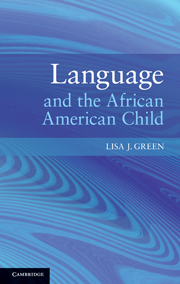Book contents
- Frontmatter
- Contents
- Figures
- Tables
- Foreword
- Preface
- Note on the text
- 1 Child AAE: an introductory overview of the data and context
- 2 Characterizing AAE: feature lists, dual components, and patterns and systems
- 3 System of tense–aspect marking 1: non-past and habitual
- 4 System of tense–aspect marking 2: past time
- 5 Negation: focus on negative concord
- 6 Asking questions: seeking clarification and requesting elaboration
- 7 Variation: intra-dialectal/variable-shifting and inter-dialectal/code-shifting
- 8 The D.I.R.E.C.T. Model: linking linguistic description and education
- Appendix A: List of participants
- Appendix B
- Notes
- References
- Index
8 - The D.I.R.E.C.T. Model: linking linguistic description and education
Published online by Cambridge University Press: 05 June 2012
- Frontmatter
- Contents
- Figures
- Tables
- Foreword
- Preface
- Note on the text
- 1 Child AAE: an introductory overview of the data and context
- 2 Characterizing AAE: feature lists, dual components, and patterns and systems
- 3 System of tense–aspect marking 1: non-past and habitual
- 4 System of tense–aspect marking 2: past time
- 5 Negation: focus on negative concord
- 6 Asking questions: seeking clarification and requesting elaboration
- 7 Variation: intra-dialectal/variable-shifting and inter-dialectal/code-shifting
- 8 The D.I.R.E.C.T. Model: linking linguistic description and education
- Appendix A: List of participants
- Appendix B
- Notes
- References
- Index
Summary
Terry: You just gotta practice, practice, practice … and don’t give up.
Introduction
I would like to end this book with a discussion that considers child AAE developmental patterns in light of practical application. I am well aware that those engaged in practical application, such as educators and speech pathologists, are always concerned about the level of feasibility of new methods of instruction, approaches, and assessments and the extent to which the methods will lead to academic gains. I hope that the type of description that has been presented in the preceding chapters and the accompanying data will be useful first in helping to discern patterns in developing AAE and will also encourage more research that will answer the many questions sparked by the data. First and foremost, I want to make clear that, on the whole, the data presented throughout the chapters represent systematic language development, not language disorders and not imperfect MAE acquisition. That point has to be reinforced; we cannot give up.
The tradition of linking AAE language use to education, and more specifically to the achievement gap between some African American students and their school-age peers from other American English backgrounds is long-standing, although there may have been some change in the themes of discussion along the way. For instance, in the linguistics-based reading program advocated in Labov (2006), emphasis is placed on the restrictions on word final sounds on the basis that the differences between the acceptable final consonant combinations in AAE and MAE may need to be underscored in phonics and reading-related lessons for AAE-speaking children. Beyond the claim that the subtle differences in sound patterns in different positions in words in AAE and MAE influence the development of decoding and phonics-related skills that are paramount to learning to read, there have not been any research-related projects that have reported findings on concrete AAE developmental linguistic patterns that present challenges for school-age children acquiring the necessary skills for mastering the academic curriculum in areas such as reading and math, although there is more recent speculation about verbal –s in third person singular contexts. The low achievement level reported for some African American children is likely to be due to multiple and complex combinations of factors, including students’ challenges in the use of academic language, a genuine misinterpretation of children’s classroom behavior on the part of educators, and students’ lack of understanding of what is expected in educational realms and the kinds of skills required for academic success. However, even in the presence of the complex factors that are barriers to children’s academic success, some researchers still maintain that while the use of AAE as a native variety may not be the sole factor serving as a barrier to academic success, it does play a role. In the limited body of current work with an AAE academic success and achievement gap thrust, the focus is on children’s ability to apply academic English in school settings. A common thread that runs through current work in this area is the advantage of code-shifting in mitigating the achievement gaps that might be linked to language. That is, according to more current studies, such as those conducted by Charity, Scarborough, and Griffin (2004) and Craig and Washington (2006), an important factor in doing well in school settings is the ability to use academic language or to shift from AAE to MAE “when necessary.” Keeping such research in mind, as the chapter progresses, I want to raise some issues in relation to the adoption of code- and variable-shifting as a strategy that bridges the gap between the native use of AAE and school language and helps to compensate for language barriers that might interfere with the processing, comprehension, and writing that are necessary for successful performance in school.
- Type
- Chapter
- Information
- Language and the African American Child , pp. 216 - 238Publisher: Cambridge University PressPrint publication year: 2010



